St Aidan's Anglican Church
cnr. Payneham & O.G. Roads, Marden (Payneham)
B [attributed] 1848 S. Marshall for St John's Anglican Church Halifax Street Adelaide?;
more likely B 1875 J.W. Wolff for St John's;
reb 1888 Fincham & Hobday; inst c.1902 St Augustine's Church Unley 1902;
inst present loc 1930. 1m, 7spst, 1c, tr. Man: 8.8 divided 8.4.4.2. Ped: 16.
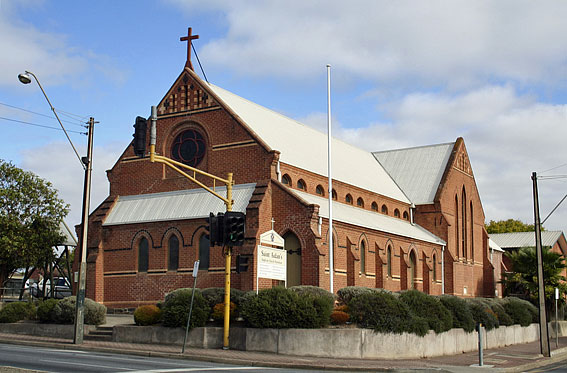

From
the 2009 OHTA Conference Book,
David Shield writes:
Though
it is hardly recognised as such now, St Aidan’s has been built on Marden Hill,
surrounded by an area of cultivated land, orchards orangeries and
vineyards. George Wyndham Kennion
was consecrated Bishop of Adelaide in London in 1882. When he arrived in Adelaide at the beginning of 1883, he
quickly realised that the Church of England had fallen badly behind in the work
of church extension. Believing
that the church should play a missionary role, he founded the Bishop’s Home
Mission Society [BHMS] to meet this need.
During the 1880s 15 churches were opened in or near Adelaide, most of
them assisted by the BHMS. It was
Kennion’s idea that these suburban missions should be given the names of Anglo-Saxon
or Celtic saints, to illustrate the early English origins of the Church of
England; for example St Aidan’s, Payneham (1884) St Cuthbert’s, Prospect
(1884), St Oswald’s, Parkside (1885), St Ninian’s, Islington (1885) and St David’s, Burnside (1887).1
The
building was to endure a stormy beginning. The church was to accommodate 150 people and initially the
chancel and part of the nave only were to be constructed. Completion was anticipated by 1 May
1884. Architects Henderson &
Marryat were engaged, the builder being John Drage. The foundation stone was laid on 2 February 1884 and Mr
Warhurst played the borrowed organ for the occasion.
12
years later, disaster struck. The
wind on Saturday morning 22 February 1896 was so violent that a front porch was
blown “into the adjoining paddock”.
The front wall was driven in on the seats and the ensuing weakness led
to the collapse of the whole of the western transept of 14 inch (36cm)
brickwork.2 The
building was sufficiently repaired for worship to recommence in April and the
Governor laid the foundation stone for the completion of the damaged section in
November 1897 Once complete, a
wooden partition divided the church forming a separate room within the Church
which remained until finally removed in October 1945 at the request of the
Bishop.3
The
organ at St Aidan’s has an interesting history. It was reputed to be the first organ made in South Australia
by Samuel Marshall for St John’s Church of England, Halifax Street, in 1848. After work by Wolff and Fincham &
Hobday it went to the first church of St Augustine in Unley before coming to St
Aidan’s in 1930. Subsequent
research has clarified some aspects of the narrative and it is most likely the
instrument now reflects the work of Fincham & Hobday.
The
first organ at St John’s Halifax Street was made by Mr Marshall and opened in
July 1848. The organ was regularly
tuned by Robert Daws who added a “a new metal stop” in 1857.4 It is doubtful if anything of this
instrument remains.
In
April 1875, 27 years later, the vestry minutes read that an order be given to
Mr Wolff for a new organ. The old
organ was sold, realizing £20, and the price of the new (allowing for the case,
which shall be used) was not to exceed £160. The organ by Wolff was opened on 20 August 1875.5 This would suggest that all pipework
and action of the Marshall instrument was to be discarded.
At
this stage, the organ was still a single manual instrument. Its compass was CC to F with one octave
of German pedals. Costing £180
complete in the church it supposedly took little more than three months to
construct, the metal pipes being imported from Speechley & Co in England
given the time frame these pipes were probably acquired by Wolff before the
order was placed.) The case was
described as “remarkably handsome” with the “gilt pipes of the open diapason
forming a very chaste front”.
Presumably this was the reused Marshall case. As given in the media report it had the following
registration: Great organ - Open diapason (metal) 8 feet 54 notes Clarabella
(with stop diapason bass) wood 8 feet 54 notes Twelfth (metal) 2 feet 54 notes
Wald Flute (wood) 4 feet to Tenor C 42 notes grooved to stop diapason. Pedal organ Bourdon (wood) 16 feet tone
16 notes Posanne (free reed) 8
feet 13notes. The tone was
regarded as “remarkably full and mellow” and the touch and internal
construction of the action “faultless”.6
The
church at St John’s became structurally unsound and had to be rebuilt. Between November 1886 and October 1887,
services were held in the School Room.
Whether the Wolff organ was damaged or the church authorities simply
took the opportunity to plan for the future is unclear. They obviously considered not only a
grandiose scheme for the building but also one for a new organ. One scheme was for a new three manual
organ of 29 speaking stops costing £1120, another of 31 speaking stops and
seven couplers with the Choir organ placed on the opposite side of the chancel,
its action controlled by the pneumatic lever.7 Neither plan transpired.
On
11 January 1888, a cheaper option was accepted. Fincham & Hobday were to “complete small organ at St
Johns”. This involved completing
the Open Diapason to CC with front pipes.
Adding a flute and fifteenth and Pedal Bourdon ccc to F. A new pedal Clavia (sic) of the latest
design CCC to F, 30 notes, was to be added, with a Pedal coupler, all for £65.8 The vestry minutes of April confirm
this offer was accepted. It was
understood “that Messrs Fincham & Hobday take the old organ and the amount
before stated [£65] to include all expenses of fixing the new organ in the
church in proper working order.”
The vestry record for the 6.30pm Service, on 3 June 1888, shows I.
Slaney Poole preached on music as an aid to worship, the occasion being the “reopening
of organ.”9 How much of
the Wolff was retained? Despite
the evidence above Stiller suggests there is no Fincham & Hobday pipework,
although the open Diapason does have its own chest and action and is clearly an
addition. On the other hand neither
the wooden ranks nor the windchests were typical of Wolff’s work, posing an
enigma.10
This
instrument remained in the church for a further 13 years before the previous
aspirations for a large organ were realised with the dedication of the J.E.
Dodd organ on 20 December 1901.11 The old one found its way to St Augustine’s. During its time there the wind may have
been supplied to the blower powered first by a gas engine then hydraulic engine.12 In 1931 the organ came to St Aidan’s
being replaced at St Augustine’s by the Bishop instrument from the Cathedral.
Until
the advent of the pipe organ, St Aidan’s used a harmonium. This was sold to the church of St
Phillip, Broadview. The organ
chamber was dedicated to the memory of the Revd J.C. Haynes on 19 October
1930. Three years later an archway
in the chamber was opened to the church and dummy pipes fitted so as to allow
greater egress of sound.13
Samuel Marshall 1848; rebuilt Johann Wilhelm
Wolff 1875;
rebuilt Fincham & Hobday 1888
1 manual, 7 speaking stops, mechanical action
|
MANUAL |
|
|
|
Open Diapason |
8 |
|
|
Stop Diapason |
8 |
CC-BB |
|
Clarabella |
8 |
TC |
|
Dulciana |
8 |
TC |
|
Principal |
4 |
|
|
Flute |
4 |
TC 1888? |
|
Fifteenth |
2 |
1888? |
|
Pedal to Keys |
|
|
|
|
|
|
|
PEDAL |
|
|
|
Pedal Bourdon |
16 |
|
Compass 56/30
Attached drawknob console
Trigger swell pedal
1 Hilliard, D., Godliness & Good
Order (1986), pp.54-55
2 Church News (28 February 1896), p. 6.1
3 Church booklet: Your
Church Welcomes You: Centenary 1884-1984 (The Anglican Parish Church of St Aidan), pp.8-14, plus newspaper
references.
4 Glover, C.R.J., Centenary
Souvenir of the Church of St John the Evangelist Halifax Street Adelaide
1839-1939, p.9 quotes the Register
(5 July 1848); State Library of South Australia SRG
94/9/4: St John’s Anglican Church Financial Statements 1853-1926: Easter 1858 General account
5 Ibid., Easter 1876; Advertiser (20 August 1875), p. 4.6; Register (20 August 1875), p. 5.6
6 Advertiser (21 August 1875), p. 4.6
7 Fincham & Hobday letters 12/162 (25
June 1886); Ibid., 12/186 (3 August 1887)
8 Ibid., 12/206 (11
January 1888)
9 State Library of South
Australia, SRG 94/9/1: St John’s Anglican Church Vestry Minutes (17 April 1888); ibid. SRG 94 9/2: St John’s
Anglican Church Vestry Record (3 June 1888)
10 Letter J. Stiller to
D.Shield, 4/11/1985. Elsewhere
Stiller notes extensive repairs in 1946 costing £110, that the Open Diapason
pipes used in the case look like Dodd, and the Dulciana possibly sounds like a
Dodd 12th. J.Stiller
record book in possession OHTA SA Committee.
11 Ibid., 20 December
1901: dedication of new organ.
12 In 1910, two letters of complaint were
received by and responded to by J.E. Dodd. Both concerned “whisperings”, probably ciphering. The reason was that after lighting the
organ gas, matches were being thrown onto the keyboard close to the thumper
slightly holding the keys down.
Clearly this relates to lighting for the organist at the keyboard and it
may be stretching things to extrapolate the use of a gas engine: DLB 1909-13, J.E. Dodd to Mr H. Rickards the warden and Mr
Bushell, the organist both dated 10 March 1910. A further letter to Bushell in 1912 talks of water pressure
problems and suggests the purchase of an electric blower: J.E. Dodd to Bushell: DLB 1909-14 (24 September 1912). This seems to be more conclusive of a hydraulic engine but
may also simply be the move away from hand pumping. See also section on St Augustine’s Anglican Church, Unley.
13 Church booklet: Your Church Welcomes
You Centenary 1884-1984 (The
Anglican Parish Church of St Aidan), p.40. Further detailed research is required to clarify the process
of acquiring the organ.

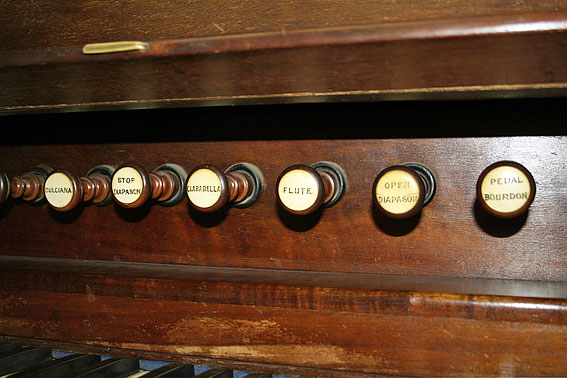
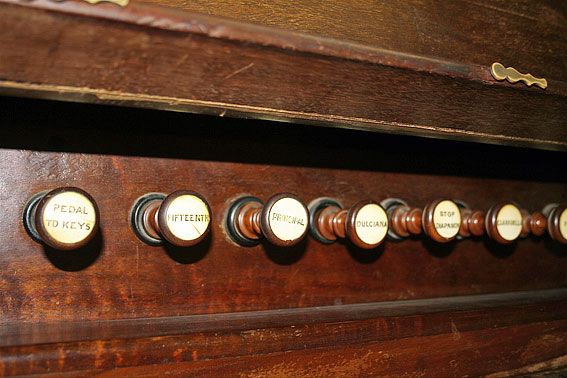
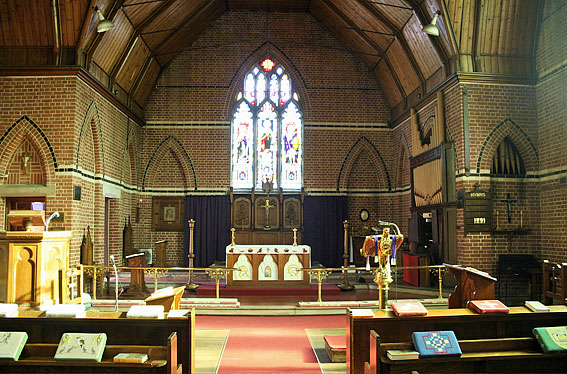
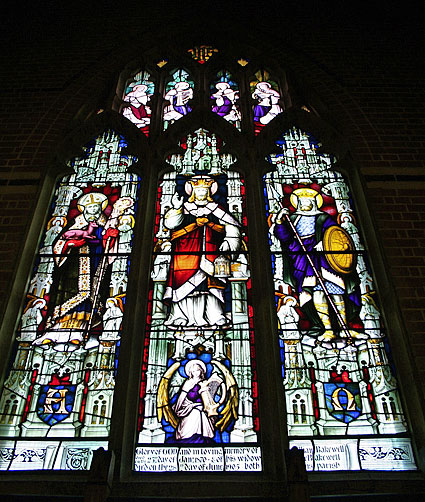

Photos: Trevor Bunning (March 2009)